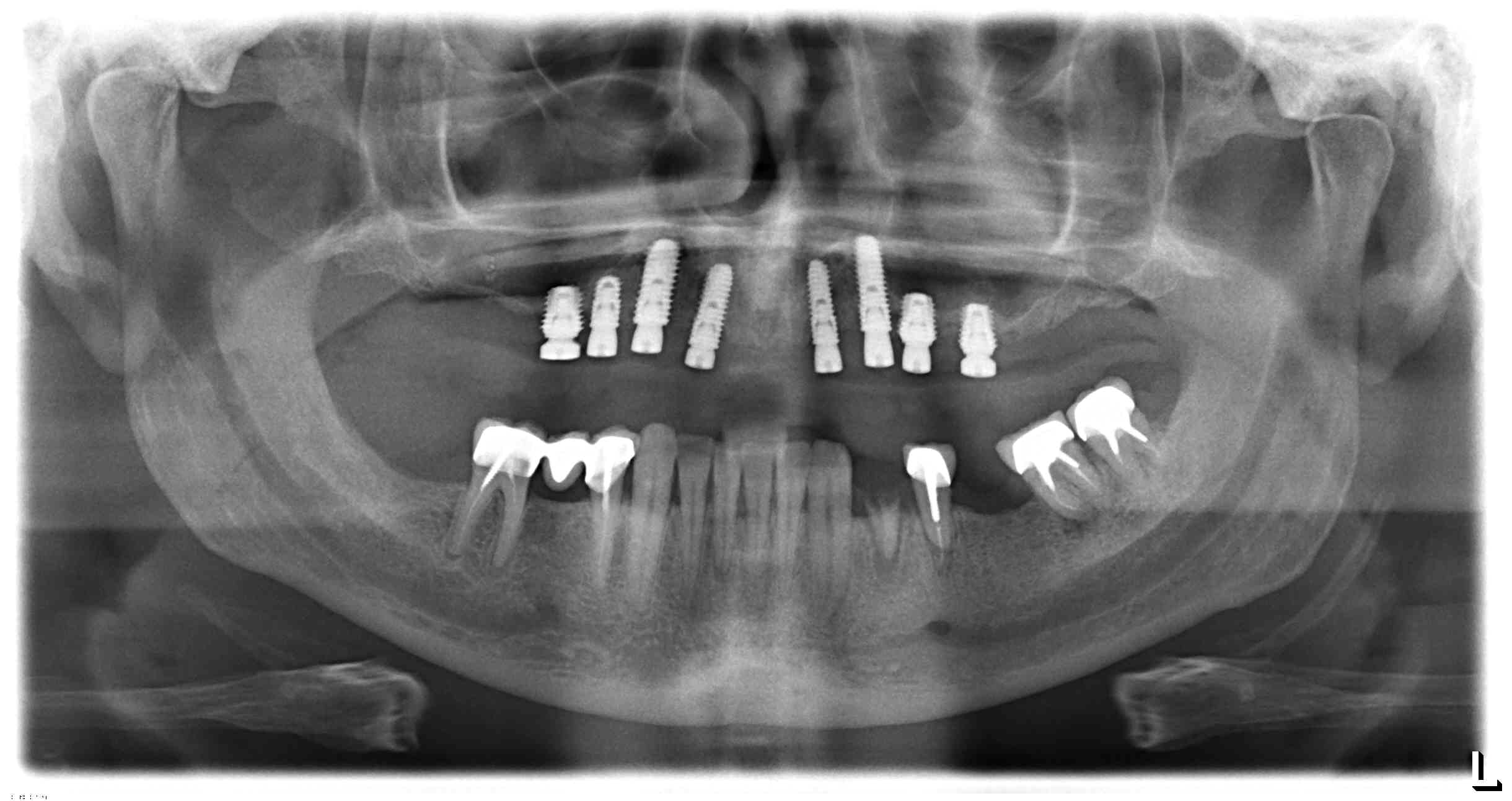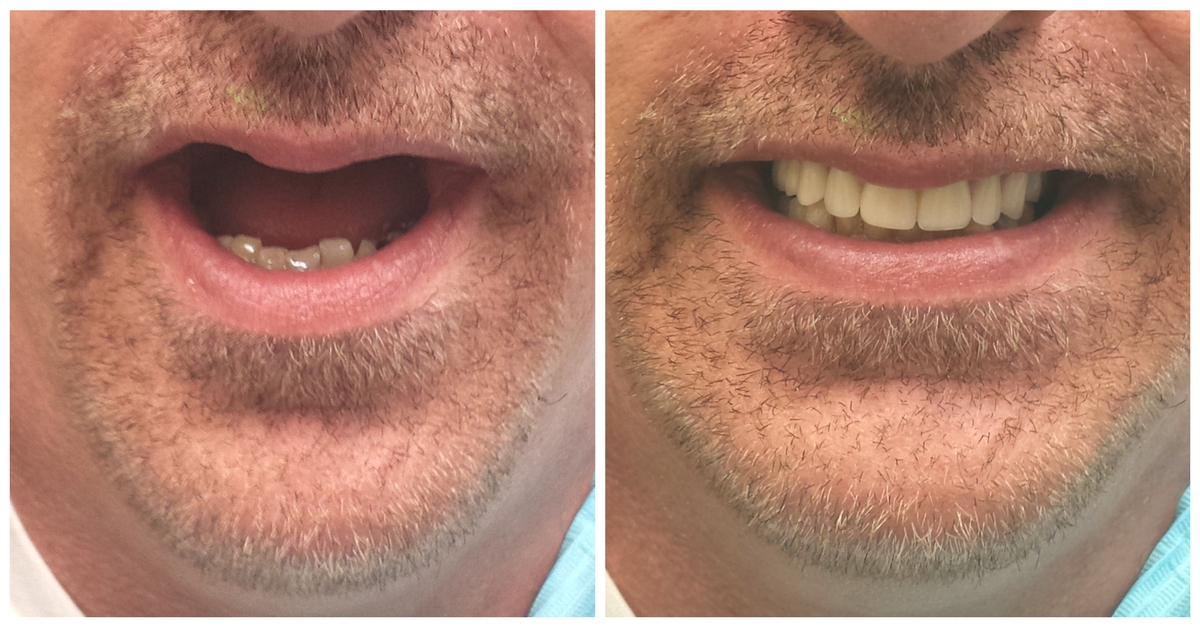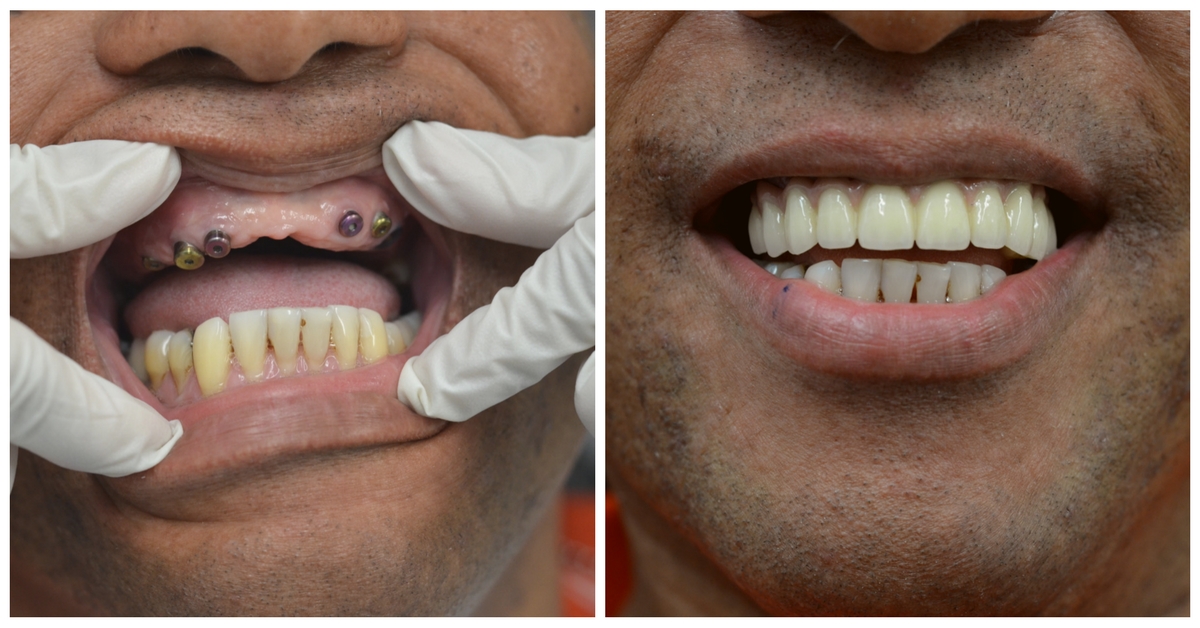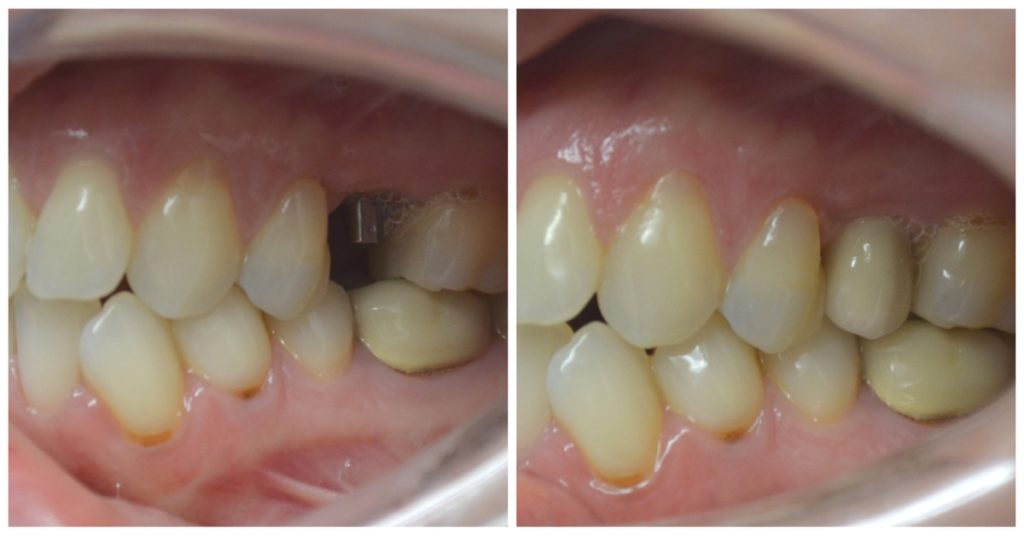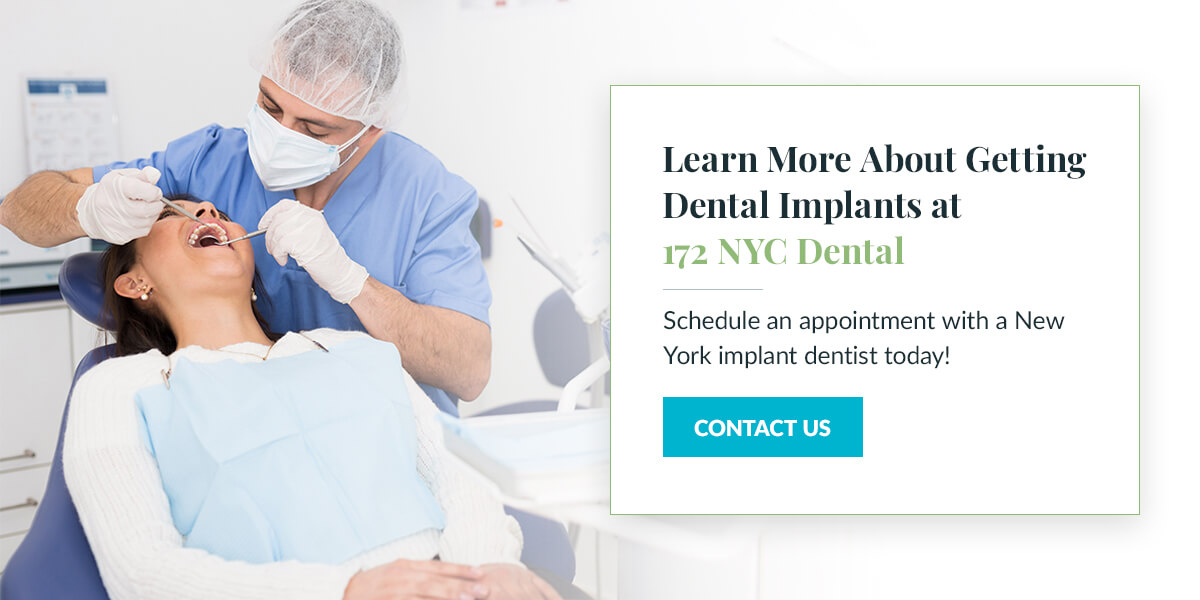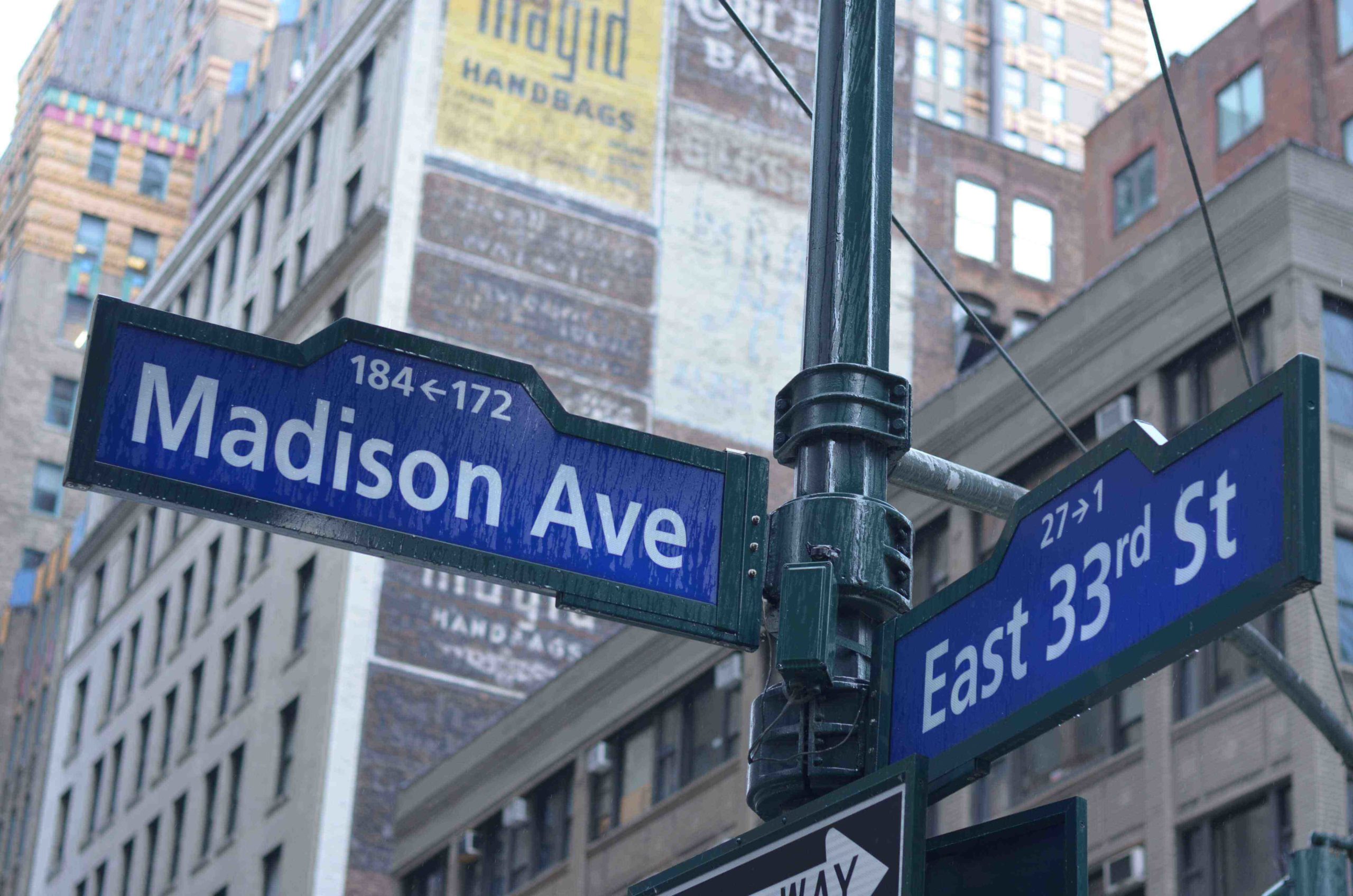The Advantages of Implants
Implants are a good choice for patients who want to replace their teeth because:
- They are easy to place in the mouth.
- They have a 99% success rate in the lower jaw and a 97% success rate in the upper jaw, where the bone is less dense.
- Adjoining teeth are not touched.
- Implants maintain bone from resorbing after extractions.
- They are cost-effective when factoring in their longevity.
- They eliminate a sunken look in the face as you age.
- They are easy to clean and floss.
- They work with single crowns, fixed bridges, and removable dentures, providing a myriad of options for restoring your smile.
The Cost of Dental Implants at 172 NYC Dental
The total cost of dental implant surgery and restoration varies from patient to patient and depends on a variety of factors. The costs of tooth implants in New York City depend on the patient as well as the location. Our experienced team can help you obtain all the necessary information to determine whether your dental insurance will cover your tooth implant cost. We can also provide in-office interest-free payment plans.
The Dental Implant Procedure
Replacing a missing tooth with a dental implant generally consists of two phases. Before those phases, the patient will have a preliminary exam, which will involve taking some very important records.
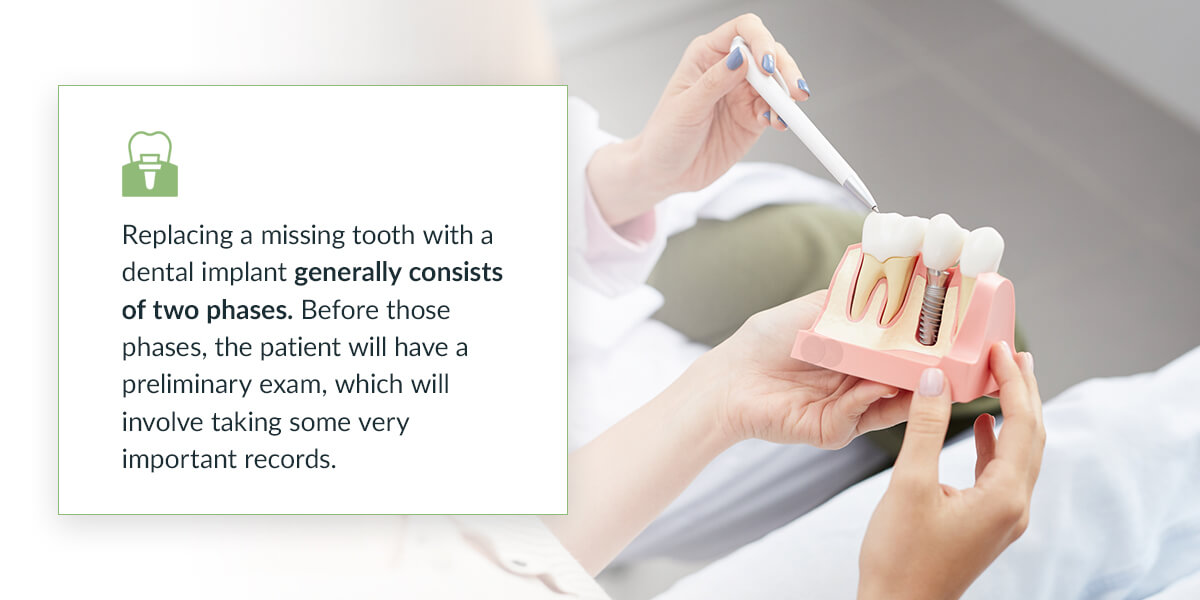
Your pre-op visit is your opportunity to learn about the procedure and ask questions. We will ask you to complete a health history and get scans taken to determine if you are the right candidate for a dental implant option. In your pre-operative exam, you will:
- Talk to the doctor: Our doctors will spend time during your consultation to get to know you, listen to your expectations, and explain what modern dentistry can offer you.
- Provide your health history: We will take a detailed medical and dental history.
- Get radiographs: We will take radiographs — including a panorex — of your upper and lower jaws.
- Get a dental cone beam computed tomography (CT): When indicated, we will use a special type of x-ray machine that will take a CT scan. This technology allows our doctors to construct a 3-D image of your teeth, soft tissues, and nerve pathways. We use this image to ensure a guided, accurate, and safe approach to placing the implant.
The days of annoying alginate tray impressions are gone — no more gagging! Our office uses a small wand with cutting-edge intraoral scanners to create the study models of your teeth.
When placing our implants, our highly trained surgeons are looking at several factors. They are looking to see that there is enough initial bone in the area to hold the implant properly. They must look at width, height, and depth. They must also make sure that there are no nerves or blood vessels near the implant site.
They very carefully review the patient’s medical history, considering any heavy smoking, drinking, diabetes, comorbidities, and medications. Finally, they confer with the restorative dentist to determine the best cosmetic placement relative to the surrounding teeth and harmonious gingival curtain.
Phase One: Surgical Phase
Our highly trained dental implant specialist performs the surgical phase of dental implant placement. During this phase, the artificial root is gently implanted into the jawbone to replace the missing tooth’s natural root. The specialist performs these procedures using lidocaine, a local anesthetic. Nitrous oxide is also available for patients who prefer it.
As we wait three months for the osseointegration to take place, we will provide a functional and esthetic temporary for our patients to enjoy. No one leaves our office without teeth.
When You Need a Bone Graft
If your current bone structure cannot support the implant immediately, we may recommend a bone graft. We can place this graft at the time of extraction or when we insert the implant. Patients experience very little discomfort from this procedure — many go back to work the very next day.
You may remove the gauze pads in your mouth about an hour after surgery. You may also eat at this time. We ask that you eat soft foods, avoid hot drinks, and do not drink from a straw for twenty-four hours following surgery.
How to Sleep After the Procedure
It is advantageous to your recovery to keep your head elevated for 72 hours following surgery. Keeping your head elevated diminishes blood flow to the surgical site, thus preventing unwanted post-operative bleeding, pain, and swelling. Apply ice to the site — ten minutes on, ten minutes off — for the first day. Frozen green peas in a plastic bag is a comfortable way to ice the surgical site.
What Painkillers to Take
Any discomfort following the implant placement is usually very minor. We recommend over-the-counter analgesic medications such as Tylenol Extra Strength, Advil, or Aleve.
When You Can Return to Work
You can go back to work the very next day. However, rest is a great healer. To promote a comfortable, complete, and quick recovery, skip the gym and take it easy for a few days.
When to Return to Our Office
Our office will be in contact with you to ensure that you are doing well. About seven days later, you will come back to the office for a post-op visit with your surgeon.
After three months of healing, our surgeon will typically uncover the gum tissue over the secure, tight implant. We perform this procedure under local anesthetic in about fifteen minutes.
Phase Two: Restorative Phase
After a few months, the implant will be ready for Phase Two — the restorative phase. The implant has now grown into the jaw bone and is very tight and secure. During your appointment, we attach an abutment — a post that screws into the implant — to this man-made root. The abutment is the infrastructure that will support the beautiful porcelain prosthesis.
A 3D scan will allow our lab to custom fabricate your implant crown, bridge, or denture. We perform this scan with a wand — no messy impressions necessary — to make a 3D model of the abutment. Once the final prosthesis is ready, we will insert and adjust it for a realistic and comfortable fit.
You will complete Phase Two in a matter of a few days, with no anesthesia required.
The Utilization of Dental Implants
We use dental implants in NYC to:
1. Replace a Missing Tooth
Tooth replacement is the easiest and most simplistic use of implants. We place the implant without having to touch the teeth on either side of the space. Once osseous integration occurs, we place the abutment and crown.
2. Install a Dental Bridge
When a group of teeth is missing, the implant dentist can place implants on both sides of the space. We place a beautiful Zirconia fixed bridge over the abutments of the implants, restoring the implants and the missing teeth. Two implants can support four missing teeth.
This prosthesis is very cost-effective. The artificial teeth between the abutment crown, called pontics, are very inexpensive, and the prosthesis is permanent. It becomes a part of your body and will last the rest of your life.
3. Support a Removable Denture
This implant is also known as “All on Four”. When you are missing all your teeth in an arch, we place four implants in the jaw to construct a removable denture that snaps onto the implants’ abutments. This is a brilliant restoration that restores 14 teeth. At the same time, it allows the cosmetic dentist to restore your missing bone, facial contour, and confidence.
In the past, Full Upper Dentures had to cover the entire palate to get stability. Patients complained of loss of taste and smell. Today, we can typically eliminate palate coverage with implant-supported dentures, giving you a sense of normalcy and personal fulfillment.
Closing the Gap During the Healing Process
While you are healing between Phase One and Phase Two, we provide several options that can fill in for the temporarily missing tooth:
- Removable flipper: A removable flipper is a removable acrylic device. Our on-site master technician constructs the flipper in our office, and we place it immediately after surgery. It immediately restores the cosmetic of the missing tooth while also helping to stop bleeding and promoting healing with natural gingival contours.
- Bonded fake tooth: When one tooth is missing in the anterior region of the mouth, we can sometimes use a composite resin to bond an artificial tooth between the two adjoining teeth. This restoration is fixed and will remain in place until we place the final restoration.
- Removable denture: After surgery, some patients no longer have any teeth left in their jaw. To help maintain dignity, esthetics, and function, our master technician will construct a removable prosthesis on-site in our office before the surgery. We will place this denture in the mouth immediately following the extractions and implant placement.
- Essex retainer: An essex retainer is a cool appliance used to replace missing teeth in the front of the mouth. We make impressions of your teeth before surgery and construct a plastic tray that includes the missing teeth. After surgery, the tray snaps over your remaining teeth, covering them as well as the empty spaces and allowing you to speak clearly. We match the plastic tray to the shade of your existing teeth, making this device esthetic, comfortable, and unobtrusive.


